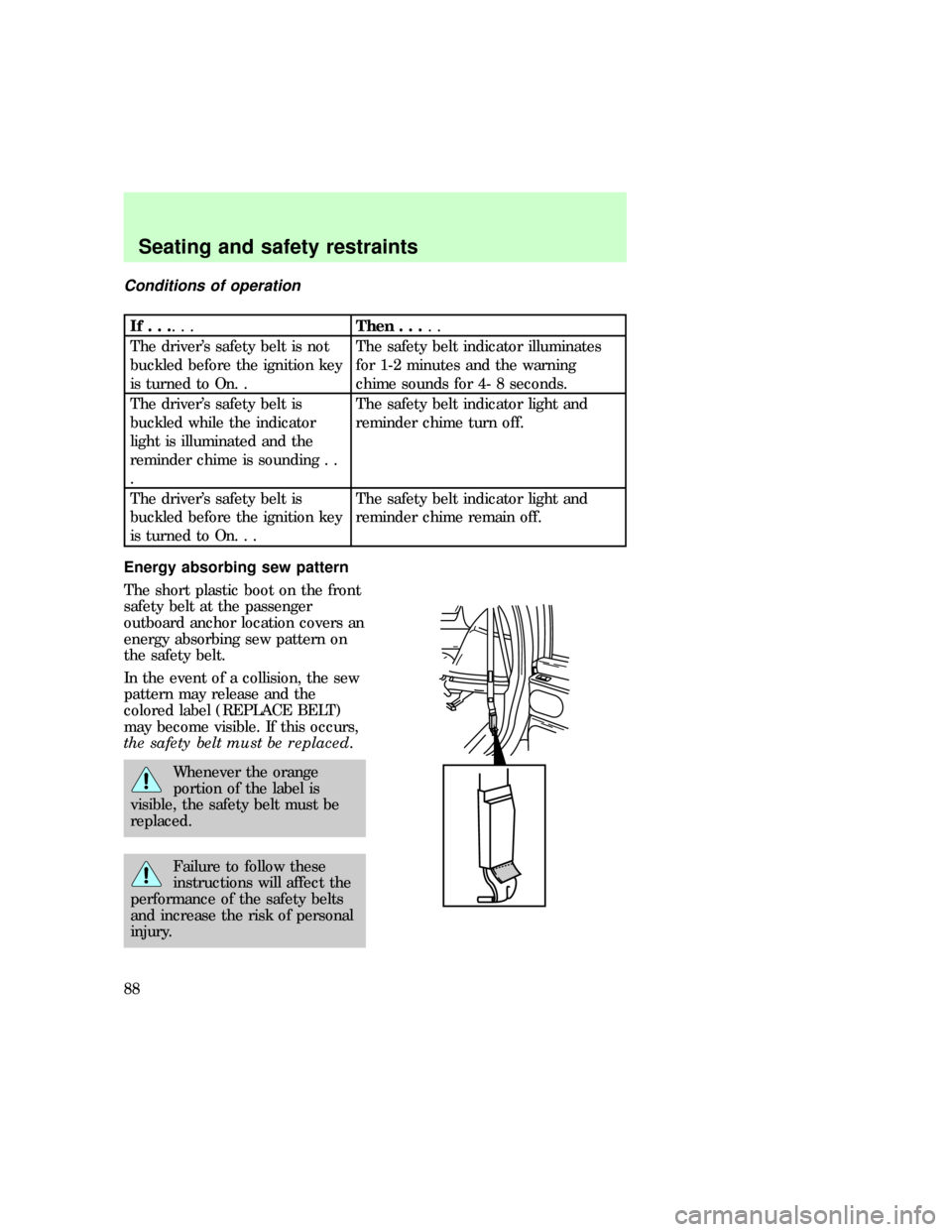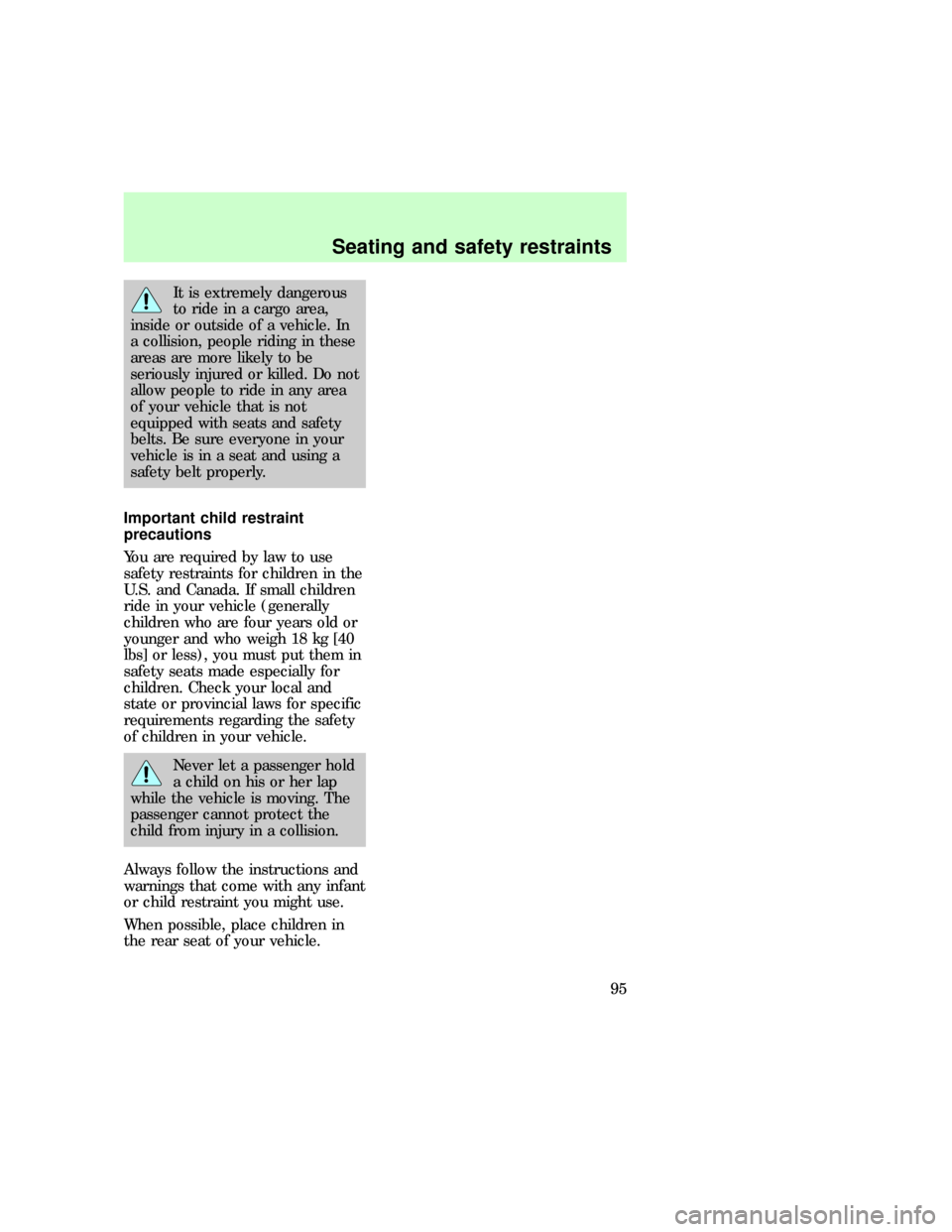Page 66 of 236
Identifying an armed anti-theft
system
When the system is armed, the
warning light will illuminate for 30
seconds. After 30 seconds, the
light will flash.
If the system is armed with the
doors open, the warning light will
stay illuminated until all the doors
are closed and then illuminate for
30 seconds and begin flashing.
When an unauthorized entry
occurs, the activated system will:
²flash the headlamps, parklamps
and the warning light in the
instrument cluster.
²sound the horn.
²prohibit the vehicle from
starting.
The flashing headlamps and
honking horn will automatically
shut off after about three minutes
and will remain off unless another
unauthorized entry is attempted.
However, the vehicle will not start
until the system is disarmed.
uno_anti-theft_disar_trig
Controls and features
67
Page 86 of 236
Using lap belts
Adjusting the lap belt
A lap belt is located in the center
of the rear seat.
To shorten the belt:
²Buckle the belt.
²Pull the loose end of the belt
until snug.
To lengthen the belt:
²Tip and pull the tongue.
Do not wear the lap belt around
your waist.
Safety belt indicator light and
warning chime
illuminates in the instrument
cluster and a chime sounds to
remind the occupants to fasten
their safety belts:
uno_adjusting_lap_belts
uno_indicator_light
Seating and safety restraints
87
Page 87 of 236

Conditions of operation
If......Then.....
The driver's safety belt is not
buckled before the ignition key
is turned to On. .The safety belt indicator illuminates
for 1-2 minutes and the warning
chime sounds for 4- 8 seconds.
The driver's safety belt is
buckled while the indicator
light is illuminated and the
reminder chime is sounding . .
.The safety belt indicator light and
reminder chime turn off.
The driver's safety belt is
buckled before the ignition key
is turned to On. . .The safety belt indicator light and
reminder chime remain off.
Energy absorbing sew pattern
The short plastic boot on the front
safety belt at the passenger
outboard anchor location covers an
energy absorbing sew pattern on
the safety belt.
In the event of a collision, the sew
pattern may release and the
colored label (REPLACE BELT)
may become visible. If this occurs,
the safety belt must be replaced.
Whenever the orange
portion of the label is
visible, the safety belt must be
replaced.
Failure to follow these
instructions will affect the
performance of the safety belts
and increase the risk of personal
injury.
uno_sbelt_maint
uno_sbelt_extension
Seating and safety restraints
88
Page 94 of 236

It is extremely dangerous
to ride in a cargo area,
inside or outside of a vehicle. In
a collision, people riding in these
areas are more likely to be
seriously injured or killed. Do not
allow people to ride in any area
of your vehicle that is not
equipped with seats and safety
belts. Be sure everyone in your
vehicle is in a seat and using a
safety belt properly.
Important child restraint
precautions
You are required by law to use
safety restraints for children in the
U.S. and Canada. If small children
ride in your vehicle (generally
children who are four years old or
younger and who weigh 18 kg [40
lbs] or less), you must put them in
safety seats made especially for
children. Check your local and
state or provincial laws for specific
requirements regarding the safety
of children in your vehicle.
Never let a passenger hold
a child on his or her lap
while the vehicle is moving. The
passenger cannot protect the
child from injury in a collision.
Always follow the instructions and
warnings that come with any infant
or child restraint you might use.
When possible, place children in
the rear seat of your vehicle.
uno_important_precautions
Seating and safety restraints
95
Page 143 of 236

working properly, the warning
lights in the instrument cluster
may not work properly.
Using a hitch
Do not use hitches that:
²clamp onto the vehicle bumper
²attach to the axle.
Distribute the load so that only 10
to 15% of the total weight of the
trailer is on the tongue. tie down
the load so that it does not shift
and change the weight on the
hitch. Follow the towing
instructions of a reputable rental
agency.
Driving while towing a trailer
Do not drive faster than 70 km/h
(45 mph) while towing a 454 kg
(1000 lb) trailer. Do not drive
faster than 72 km/h (45 mph) with
any weight trailer while towing in
hilly terrain or on hot days.
Speed control (if equipped) may
not work properly while towing on
long, steep grades.
If driving with an automatic
transmission:
²use D or L rather than while
towing up or down steep hills
²anticipate stops and brake
gradually.
Towing behind another vehicle
Do not tow your vehicle behind
another vehicle, such as an RV,
unless front wheel dollies are used.
uno_hitch
uno_driving_towing
uno_towing_behind
Driving
144
Page 146 of 236
HAZARD LIGHTS CONTROL
Use only in an emergency to warn
traffic of vehicle breakdown,
approaching danger, etc. Depress
to activate all indicators
simultaneously. Depress again to
switch off. The warning lights can
be operated when the ignition is
off.
FUEL PUMP SHUT-OFF SWITCH
If the engine cranks but does not
start after a collision, the fuel
pump shut±off switch may have
been activated. The shut±off
switch is a device intended to stop
the electric fuel pump when your
vehicle has been involved in a
substantial jolt.
0P RND21
UNLEADED
FUEL ONLY
RPM x 100012345
6H
C
F
E
RSM
SET
ACC
COAST OFF ON
SRS
- +H
H
L L020
1030405060
70
80
90
110
120000000oooo
km/h10020406080100
120
140
160
180
uno_hazard_switch uno_fuel_shut-off
Roadside emergencies
147
Page 150 of 236
Number Fuse Amperage
RatingCircuits Protected
1 7.5 amp Power mirror, power
antenna
2 7.5 amp High-mount brakelamp
3 15 amp Parking lamp,
instrument cluster
gauges
4 10 amp Left headlamp, lamp
out warning
5 10 amp OBD system
6 7.5 amp Air bag system, blower
relay, EATC
7 7.5 amp Illumination switches
8 10 amp Right headlamp, fog
lamp system, DRL,
lamp out warning
9 10 amp EATC system, seat
memory, message
center, cellular phone,
autolamps
10 7.5 amp EATC system, rear
blower, speed control,
GEM system, brake
interlock, overhead
console, automatic
ride control, lamp out
warning
11 7.5 amp Warning lamps,
autolamp
12 10 amp Front washer, rear
washer & wiper
Roadside emergencies
151
Page 196 of 236

Warning: The traction grade
assigned to this tire is based on
braking (straightahead) traction
tests and does not include
cornering (turning) traction.
Temperature A B C
The temperature grades are A (the
highest), B, and C, representing
the tire's resistance to the
generation of heat and its ability to
dissipate heat when tested under
controlled conditions on a
specified indoor laboratory test
wheel. Sustained high temperature
can cause the material of the tire
to degenerate and reduce tire life,
and excessive temperature can
lead to sudden tire failure. The
grade C corresponds to a level of
performance which all passenger
car tires must meet under the
Federal Motor Vehicle Safety
Standard No. 109. Grades B and A
represent higher levels of
performance on the laboratory test
wheel than the minimum required
by law.
The temperature grade for
this tire is established for a
tire that is properly inflated and
not overloaded. Excessive speed,
underinflation, or excessive
loading, either separately or in
combination, can cause heat
buildup and possible tire failure.
Checking the tire pressure
Check the tire pressure
periodically and inflate tires as
com_temperature_abc.01
uno_pressure_tires
Maintenance and care
197